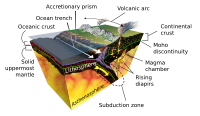
Photo from wikipedia
Interpretation of new multichannel seismic reflection data from the Andaman Forearc Basin (AFB) in the northern Indian Ocean is presented here. The high-quality multichannel seismic data from the Andaman Forearc… Click to show full abstract
Interpretation of new multichannel seismic reflection data from the Andaman Forearc Basin (AFB) in the northern Indian Ocean is presented here. The high-quality multichannel seismic data from the Andaman Forearc region enable us to examine the seismic characters and to demarcate seismic sequences bounded by distinct unconformities. Ages of marked seismic horizons have been calibrated with available litholog data from nearby industry boreholes. Seismic interpretation of new data shows that the AFB is filled with ~ 4.5-s-two way travel time (TWT) thick Neogene to Recent sediments. The entire basin assemblage exhibits two distinct major sequences pertaining to the Neogene and Quaternary times. A large part of the basin is filled with intermittent mass transport deposits (MTD). We infer that the episodic uplift of the Invisible Bank, protuberance of the outerarc and regular deformation through reactivation of preexisting normal faults since the Pleistocene could be attributed as causal mechanisms for the MTDs. Strong bottom simulating reflectors are identified in the Late Miocene and younger sediments of the outerarc and AFB at a depth of ~ 0.6 s TWT and correspond to the presence of gas hydrates in this region. Our interpretations have significant implications for geodynamic as well as resource exploration in the AFB.
Journal Title: Petroleum Science
Year Published: 2017
Link to full text (if available)
Share on Social Media: Sign Up to like & get
recommendations!